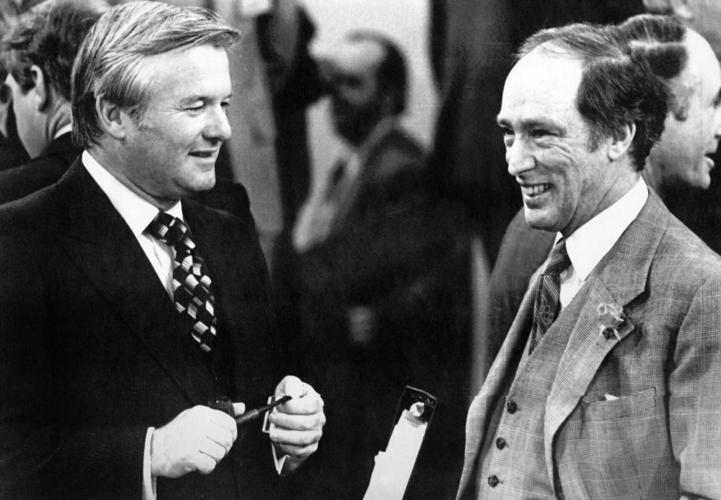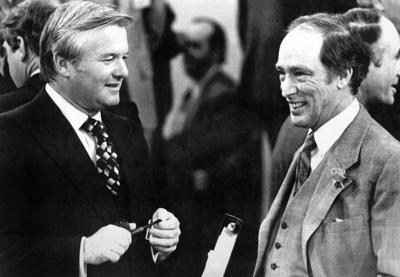The final setting to conclude months of negotiations between those two great Canadian institutions of long-standing, federal-provincial feuding and government-business wariness, was on a uniquely Canadian stage: the rip-roaring Calgary Stampede.
The topic was not horses, it was money and jobs. In 1978, U.S.-based Ford Motor Co. was thinking about building a V6-engine plant in Windsor, Ont. But the company wanted some public money, $30 million, said Roy Bennett, Ford Motor Co. of Canada president. The injection would offset a variety of higher Canadian costs compared with expanding an existing Ford engine plant in Lima, Ohio, 150 kilometres across the border from Windsor.
At stake was much more than just the 2,600 jobs the new $500-million plant would create in Windsor. The future would surely bring more plants as North American automakers spent billions over the next few years making smaller, lighter vehicles to conserve energy and meet tough new environmental standards.
While the Auto Pact, signed by the U.S. and Canada in 1965, had brought added economic growth to Canada, it had no real influence on where companies created jobs nor did it guarantee balanced trade.
Moreover, there was an uneasy feeling in Canada that if Ohio were selected for this plant, the whole momentum of auto industry investment could shift irreversibly toward the U.S. In Ontario, where the auto industry accounted for one job in every six, such southward movement mattered.
For its part, Ford claimed it wasnât demanding government help but everyone knew Pennsylvania had recently won a Volkswagen plant with a multimillion-dollar package.
Ottawa decided that Ontario should be involved in any talks and asked the province in February for 25 per cent of the $30 million in aid that Ford said was needed. Ontario declined. âIt would be incredible to offer massive subsidies to the largest manufacturing corporations in the world,â declared Ontario Treasurer Darcy McKeough.
Federal Finance Minister Jean Chrétien met in June with McKeough and Ontario Minister of Industry and Tourism John Rhodes but no progress was made. Matters remained unchanged until Ford upped its request to $75 million from $30 million. Ontario now agreed its help was required and said it would come in for $18.75 million, a quarter of Ford’s request, the same proportion as Ottawa had previously suggested.Â
The federal cabinet countered by suggesting a 50-50 split, or $37.5 million each. Stunned that Ottawa would renege on its previous offer where Ontario paid one-quarter, Ontario returned to the table with $25 million, one-third of the new total, meaning that $50 million would come from Ottawa. Prime Minister Pierre Trudeau accused Ontario of âdragging its feet,â adding ominously, âFull stop.â
Talks continued behind the scenes, led by federal deputy minister G.F. Osbaldeston and Ontario Industry and Tourism deputy minister James Fleck. Discussions also occurred between senior Ontario civil servant Ed Stewart and Jim Coutts, Trudeauâs principal secretary.
Hearing nothing, Bennett boarded a plane for Calgary simply because he knew the major players would all be at the Stampede. By then officials had confirmed their growing suspicions that Fordâs demand for $75 million was likely too high. Both governments adjusted their positions. New numbers were exchanged even as Trudeau and Jack Horner, his industry, trade and commerce minister, rode horses in the Stampede parade.
Next, the two greeted parade-watchers, then joined Ontario Premier Bill Davis on the viewing stand to watch part of the three-hour parade.
Shortly after high noon, the poker players gathered to play their final hand. Standing at a reception, as scores of attendees milled about with drinks in their hands, were Trudeau, Horner, Davis and Fordâs Bennett.
Trudeau agreed to put up $40 million with Davis adding $28 million, about a 60-40 split on the pot of aid that had now been anted-up by the two governments. Bennett was pleased when he heard the outcome.
Ohio had also made an offer, not known in any detail to the Canadians, but Ford chose Windsor. Said William Bourke, executive vice-president for Fordâs North American operations, the final Canadian offer made the two sites âabout a wash.â
But for some in Ontario, winning didnât seem like a positive outcome. Said one official, âIf you hold out and the deficit continues and the investment goes somewhere else, youâre accused of not doing anything; if you go along, youâre accused of complying with blackmail; if you make an offer and miss, youâre accused of being cheap; if you get into it and youâre successful, youâre accused of giving away the taxpayerâs money.â
Since those days Ford has continued to build vehicles in Ontario but new negotiators have taken over tariffs and trade: U.S. President Donald Trump and Canadian Prime Minister Mark Carney. Talks seem just as fraught today as they were back in 1978. Canada won in those days, but with Trumpâs almost hourly changes of heart, the past may not be prologue.


































To join the conversation set a first and last name in your user profile.
Sign in or register for free to join the Conversation